牛津译林版九年级英语下册Unit1Asia Grammar教案设计
牛津译林版九年级下册Unit1《Asia》说课稿6
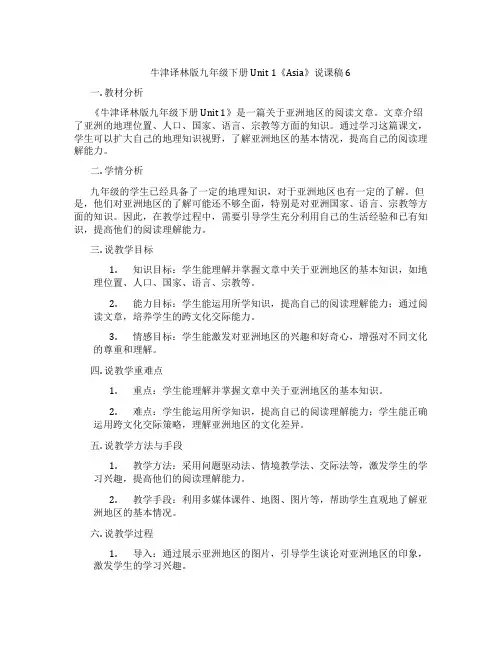
牛津译林版九年级下册Unit 1《Asia》说课稿6一. 教材分析《牛津译林版九年级下册Unit 1》是一篇关于亚洲地区的阅读文章。
文章介绍了亚洲的地理位置、人口、国家、语言、宗教等方面的知识。
通过学习这篇课文,学生可以扩大自己的地理知识视野,了解亚洲地区的基本情况,提高自己的阅读理解能力。
二. 学情分析九年级的学生已经具备了一定的地理知识,对于亚洲地区也有一定的了解。
但是,他们对亚洲地区的了解可能还不够全面,特别是对亚洲国家、语言、宗教等方面的知识。
因此,在教学过程中,需要引导学生充分利用自己的生活经验和已有知识,提高他们的阅读理解能力。
三. 说教学目标1.知识目标:学生能理解并掌握文章中关于亚洲地区的基本知识,如地理位置、人口、国家、语言、宗教等。
2.能力目标:学生能运用所学知识,提高自己的阅读理解能力;通过阅读文章,培养学生的跨文化交际能力。
3.情感目标:学生能激发对亚洲地区的兴趣和好奇心,增强对不同文化的尊重和理解。
四. 说教学重难点1.重点:学生能理解并掌握文章中关于亚洲地区的基本知识。
2.难点:学生能运用所学知识,提高自己的阅读理解能力;学生能正确运用跨文化交际策略,理解亚洲地区的文化差异。
五. 说教学方法与手段1.教学方法:采用问题驱动法、情境教学法、交际法等,激发学生的学习兴趣,提高他们的阅读理解能力。
2.教学手段:利用多媒体课件、地图、图片等,帮助学生直观地了解亚洲地区的基本情况。
六. 说教学过程1.导入:通过展示亚洲地区的图片,引导学生谈论对亚洲地区的印象,激发学生的学习兴趣。
2.读前预测:让学生根据文章标题和插图,预测文章可能涉及的内容。
3.阅读理解:学生快速阅读文章,回答问题,检测学生对文章的理解程度。
4.精讲细读:教师引导学生深入分析文章,理解文章中关于亚洲地区的基本知识。
5.小组讨论:学生分组讨论,交流对亚洲地区的了解,分享学习心得。
6.课堂小结:教师总结课堂教学内容,强调重点知识。
牛津译林版英语九下Unit 1《Asia》(Revision)教学设计
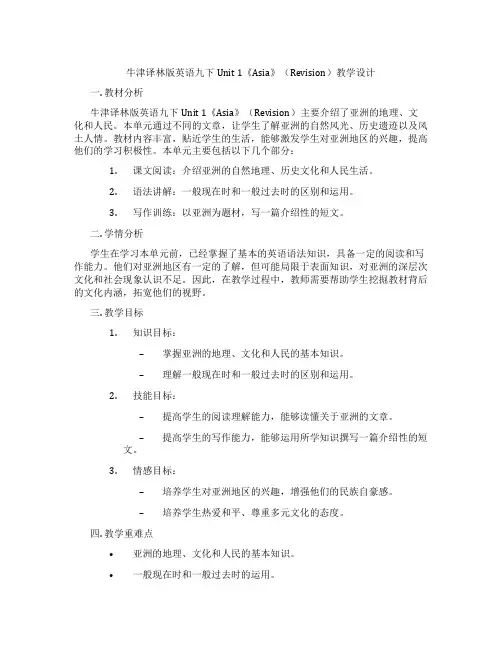
牛津译林版英语九下Unit 1《Asia》(Revision)教学设计一. 教材分析牛津译林版英语九下Unit 1《Asia》(Revision)主要介绍了亚洲的地理、文化和人民。
本单元通过不同的文章,让学生了解亚洲的自然风光、历史遗迹以及风土人情。
教材内容丰富,贴近学生的生活,能够激发学生对亚洲地区的兴趣,提高他们的学习积极性。
本单元主要包括以下几个部分:1.课文阅读:介绍亚洲的自然地理、历史文化和人民生活。
2.语法讲解:一般现在时和一般过去时的区别和运用。
3.写作训练:以亚洲为题材,写一篇介绍性的短文。
二. 学情分析学生在学习本单元前,已经掌握了基本的英语语法知识,具备一定的阅读和写作能力。
他们对亚洲地区有一定的了解,但可能局限于表面知识,对亚洲的深层次文化和社会现象认识不足。
因此,在教学过程中,教师需要帮助学生挖掘教材背后的文化内涵,拓宽他们的视野。
三. 教学目标1.知识目标:–掌握亚洲的地理、文化和人民的基本知识。
–理解一般现在时和一般过去时的区别和运用。
2.技能目标:–提高学生的阅读理解能力,能够读懂关于亚洲的文章。
–提高学生的写作能力,能够运用所学知识撰写一篇介绍性的短文。
3.情感目标:–培养学生对亚洲地区的兴趣,增强他们的民族自豪感。
–培养学生热爱和平、尊重多元文化的态度。
四. 教学重难点•亚洲的地理、文化和人民的基本知识。
•一般现在时和一般过去时的运用。
•理解亚洲文化背后的深层次含义。
•运用所学知识撰写一篇介绍性的短文。
五. 教学方法1.任务型教学法:通过完成各种任务,让学生在实践中掌握知识。
2.情境教学法:创设真实的情境,让学生在特定的环境中感受和理解知识。
3.合作学习法:鼓励学生相互合作,共同探讨问题,培养团队精神。
六. 教学准备1.教材:牛津译林版英语九下Unit 1《Asia》(Revision)。
2.多媒体设备:电脑、投影仪、音响等。
3.教学素材:相关图片、视频、音频等。
九年级英语下册 Unit 1 Asia grammar教案 (新版)牛津版 教案
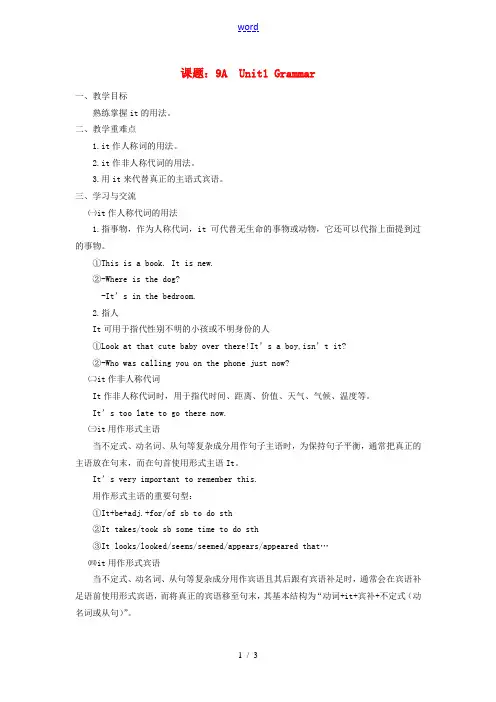
课题:9A Unit1 Grammar一、教学目标熟练掌握it的用法。
二、教学重难点1.it作人称词的用法。
2.it作非人称代词的用法。
3.用it来代替真正的主语式宾语。
三、学习与交流㈠it作人称代词的用法1.指事物,作为人称代词,it可代替无生命的事物或动物,它还可以代指上面提到过的事物。
①This is a book. It is new.②-Where is the dog?-It’s in the bedroom.2.指人It可用于指代性别不明的小孩或不明身份的人①Look at that cute baby over there!It’s a boy,isn’t it?②-Who was calling you on the phone just now?㈡it作非人称代词It作非人称代词时,用于指代时间、距离、价值、天气、气候、温度等。
It’s too late to go there now.㈢it用作形式主语当不定式、动名词、从句等复杂成分用作句子主语时,为保持句子平衡,通常把真正的主语放在句末,而在句首使用形式主语It。
It’s very important to remember this.用作形式主语的重要句型:①It+be+adj.+for/of sb to do sth②It takes/took sb some time to do sth③It looks/looked/seems/seemed/appears/appeared that…㈣it用作形式宾语当不定式、动名词、从句等复杂成分用作宾语且其后跟有宾语补足时,通常会在宾语补足语前使用形式宾语,而将真正的宾语移至句末,其基本结构为“动词+it+宾补+不定式(动名词或从句)”。
达标检测一、选择( )1.I can’t find my ticket. I think I must have lost _________.( )2.Bill thought ________ necessary to work with friends and share different ideas.( )3.Television has made ________possible for us to watch movies at home.( )4.It ________a boy or a girt?( )5.Here is a plastic box. ________ is useful.( )6.There is a knock on the door. ________must be the postman.( )7.________was foolish ________her to say such a thing.’’s,of( )8.________took me 2 hours ________ my homework.’s,to finish C.It, to finish D.It, finishing( )9.I found________difficult ________the job well.’s, to do C.it, to do D.it, doing( )10.We decide to make ________ a rule for us roommates to rurn off the lights at 10:30p.m.( )11.You can take ________of the two toy cars and leave the other for your brother.( )12.In Singapore,more them three quarters of the population are Chinese.(选出与画线部分意思相同或相近的一项。
牛津译林版英语九年级下册《Unit 1 Asia Welcome to the unit》教学设计8
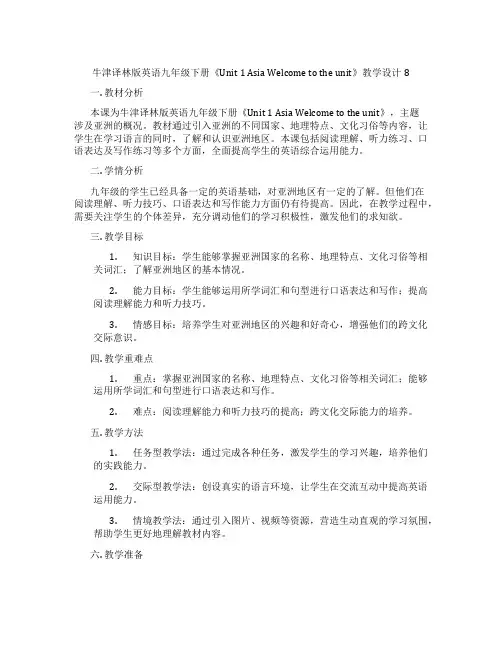
牛津译林版英语九年级下册《Unit 1 Asia Welcome to the unit》教学设计8一. 教材分析本课为牛津译林版英语九年级下册《Unit 1 Asia Welcome to the unit》,主题涉及亚洲的概况。
教材通过引入亚洲的不同国家、地理特点、文化习俗等内容,让学生在学习语言的同时,了解和认识亚洲地区。
本课包括阅读理解、听力练习、口语表达及写作练习等多个方面,全面提高学生的英语综合运用能力。
二. 学情分析九年级的学生已经具备一定的英语基础,对亚洲地区有一定的了解。
但他们在阅读理解、听力技巧、口语表达和写作能力方面仍有待提高。
因此,在教学过程中,需要关注学生的个体差异,充分调动他们的学习积极性,激发他们的求知欲。
三. 教学目标1.知识目标:学生能够掌握亚洲国家的名称、地理特点、文化习俗等相关词汇;了解亚洲地区的基本情况。
2.能力目标:学生能够运用所学词汇和句型进行口语表达和写作;提高阅读理解能力和听力技巧。
3.情感目标:培养学生对亚洲地区的兴趣和好奇心,增强他们的跨文化交际意识。
四. 教学重难点1.重点:掌握亚洲国家的名称、地理特点、文化习俗等相关词汇;能够运用所学词汇和句型进行口语表达和写作。
2.难点:阅读理解能力和听力技巧的提高;跨文化交际能力的培养。
五. 教学方法1.任务型教学法:通过完成各种任务,激发学生的学习兴趣,培养他们的实践能力。
2.交际型教学法:创设真实的语言环境,让学生在交流互动中提高英语运用能力。
3.情境教学法:通过引入图片、视频等资源,营造生动直观的学习氛围,帮助学生更好地理解教材内容。
六. 教学准备1.教材:牛津译林版英语九年级下册《Unit 1 Asia Welcome to the unit》。
2.多媒体设备:电脑、投影仪、音响等。
3.教学资源:图片、视频、音频等。
七. 教学过程1.导入(5分钟)利用图片、视频等教学资源,引导学生谈论关于亚洲的已知信息,激发学生的学习兴趣。
牛津译林版九年级下册《Asia》教案1
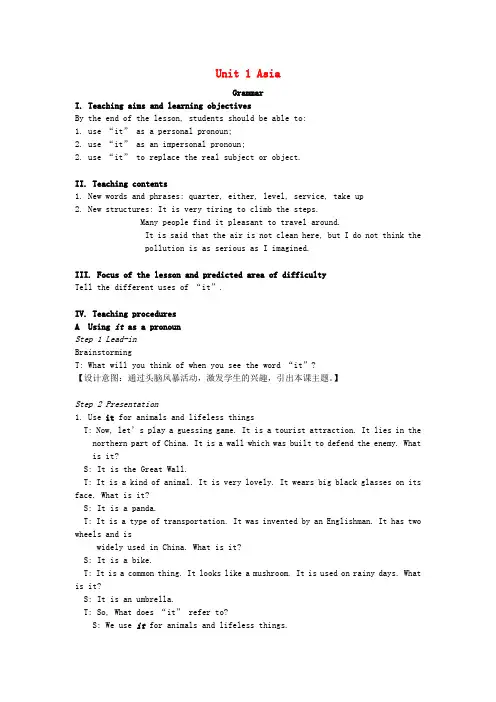
Unit 1 AsiaGrammarI. Teaching aims and learning objectivesBy the end of the lesson, students should be able to:1. use “it” as a personal pronoun;2. use “it” as an impersonal pronoun;2. use “it” to replace the real subject or object.II. Teaching contents1. New words and phrases: quarter, either, level, service, take up2. New structures: It is very tiring to climb the steps.Many people find it pleasant to travel around.It is said that the air is not clean here, but I do not think thepollution is as serious as I imagined.III. Focus of the lesson and predicted area of difficultyTell the different uses of “it”.IV. Teaching proceduresA Using it as a pronounStep 1 Lead-inBrainstormingT: What will you think of when you see the word “it”?【设计意图:通过头脑风暴活动,激发学生的兴趣,引出本课主题。
】Step 2 Presentation1. Use it for animals and lifeless thingsT: Now, let’s play a guessing game. It is a tourist attraction. It lies in the northern part of China. It is a wall which was built to defend the enemy. What is it?S: It is the Great Wall.T: It is a kind of animal. It is very lovely. It wears big black glasses on its face. What is it?S: It is a panda.T: It is a type of transportation. It was invented by an Englishman. It has two wheels and iswidely used in China. What is it?S: It is a bike.T: It is a common thing. It looks like a mushroom. It is used on rainy days. What is it?S: It is an umbrella.T: So, What does “it” refer to?S: We use it for animals and lifeless things.【设计意图:利用学生喜欢的猜谜游戏,激发他们的学习兴趣,在不知不觉中过渡至语法学习,将it指代动物或者无生命的事物的用法自然呈现。
译林版英语9年级下册Unit 1 Asia 教案2
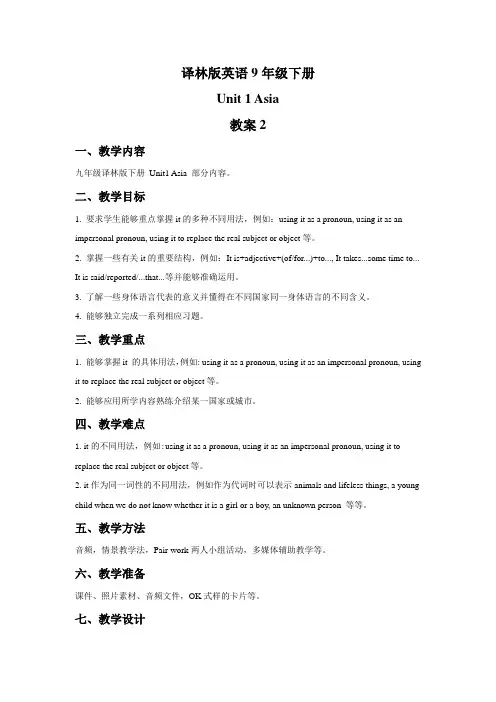
译林版英语9年级下册Unit 1 Asia教案2一、教学内容九年级译林版下册Unit1 Asia 部分内容。
二、教学目标1. 要求学生能够重点掌握it的多种不同用法,例如:using it as a pronoun, using it as an impersonal pronoun, using it to replace the real subject or object等。
2. 掌握一些有关it的重要结构,例如:It is+adjective+(of/for...)+to..., It takes...some time to... It is said/reported/...that...等并能够准确运用。
3. 了解一些身体语言代表的意义并懂得在不同国家同一身体语言的不同含义。
4. 能够独立完成一系列相应习题。
三、教学重点1. 能够掌握it 的具体用法,例如: using it as a pronoun, using it as an impersonal pronoun, using it to replace the real subject or object等。
2. 能够应用所学内容熟练介绍某一国家或城市。
四、教学难点1. it的不同用法,例如:using it as a pronoun, using it as an impersonal pronoun, using it to replace the real subject or object等。
2. it作为同一词性的不同用法,例如作为代词时可以表示animals and lifeless things, a young child when we do not know whether it is a girl or a boy, an unknown person 等等。
五、教学方法音频,情景教学法,Pair-work两人小组活动,多媒体辅助教学等。
Unit1AsiaGrammar-2023-2024学年九年级下册英语同步教案(牛津译林版)
(三)实践活动(用时10分钟)
1.分组讨论:学生们将分成若干小组,每组讨论一个与亚洲国家相关的实际问题,如描述春节的庆祝活动。
2.实验操作:为了加深理解,我们将进行一个简单的口头描述练习。这个练习将演示现在进行时态和比较级、最高级的基本原理。
3.成果展示:每个小组将向全班展示他们的讨论成果和描述练习的结果。
(四)学生小组讨论(用时10分钟)
1.讨论主题:学生将围绕“现在进行时态和比较级、最高级在描述亚洲国家中的应用”这一主题展开讨论。他们将被鼓励提出自己的观点和想法,并与其他小组成员进行交流。
2.引导与启发:在讨论过程中,我将作为一个引导者,帮助学生发现问题、分析问题并解决问题。我会提出一些开放性的问题来启发他们的思考。
1.注重个体差异,因材施教,提高教学效果;
2.加强对案例的讲解和引导,确保学生能够充分理解;
3.增加口语练习环节,提高学生的英语表达能力;
4.加强小组讨论的引导,促进学生的思考和交流。
2.增强学生的文化意识,通过了解亚洲各国文化,培养学生尊重不同文化、包容多元价值观的态度;
3.培养学生的思维品质,通过对比分析亚洲各国特点,激发学生批判性思维和创新思维;
4.提高学生的学习能力,引导学生运用所学知识进行自主、合作、探究学习,培养学生解决问题的能力。
三、教学难点与重点
1.教学重点
(1)语法知识:现在进行时态的构成及其用法,比较级和最高级的构成与运用。
实践活动环节,我鼓励学生们积极参与,尽量让每个学生都有机会开口说英语。从成果展示来看,学生们在小组合作中表现出色,但仍有一些学生在口头表达上显得不够自信。为此,我计划在接下来的课程中,增加一些口语练习环节,帮助学生们提高口语表达能力,增强他们的自信心。
牛津译林版九年级下Unit1 Asia Grammar导学案(英语教案)
改:Practise more.
3. Was_______that I saw last night at the concert?
A. it you B. not you C. you D. that yourself
4. There is a photo on the wall.________ a photo of Marx.
e.g. Reading around the countryside is popular in Guilin, isn’t it?
Task 2
Read the passage below and find out what each it refers to. Write the answers in the blanks.
e.g. It is 6:30 p.m. It is raining heavily outside.
It is 1 January today. It is New Year's Day.
In Beijing, it is cold and windy in winter.
It is two kilometres from my school to my home
(3)We use it for an unknown person.
e.g. — Who was calling you on the phone just now?
— It was my cousin.
(4) We use it for an action, a situation or an idea mentioned in a previous statement.
牛津译林版英语九下Unit 1《Asia》(Task)教学设计
牛津译林版英语九下Unit 1《Asia》(Task)教学设计一. 教材分析牛津译林版英语九下Unit 1《Asia》主要介绍了亚洲的自然地理、人文地理以及亚洲各国的主要城市。
本单元的话题贴近学生的生活实际,有利于激发学生的学习兴趣,提高他们的跨文化交际能力。
本节课的Task部分主要让学生运用所学知识介绍自己喜欢的城市,培养学生的写作能力和合作能力。
二. 学情分析学生在学习本单元前,已经掌握了有关地理、气候、城市等基本词汇和句型。
此外,他们对亚洲的一些国家和地区有一定的了解。
然而,学生在写作和口语表达方面还存在一定的困难,如语言能力、词汇搭配等。
因此,在教学过程中,教师需要关注学生的个体差异,充分调动学生的积极性和主动性。
三. 教学目标1.知识目标:学生能够掌握有关城市介绍的词汇和句型,如“The city isfamous for…”,“One of the most famous landmarks is…”等。
2.能力目标:学生能够运用所学知识介绍自己喜欢的城市,提高写作和口语表达能力。
3.情感目标:通过介绍自己喜欢的城市,培养学生对家乡和祖国的热爱之情。
四. 教学重难点1.重点:学生能够掌握有关城市介绍的词汇和句型。
2.难点:学生能够运用所学知识灵活介绍自己喜欢的城市,并在写作和口语表达中运用恰当的词汇和句型。
五. 教学方法1.任务型教学法:通过完成具体任务,让学生在实践中学习和运用语言。
2.合作学习法:学生分组进行讨论和写作,培养学生的团队合作能力和沟通能力。
3.情境教学法:创设真实的情境,让学生在实际语境中学习和运用语言。
六. 教学准备1.教师准备:提前准备相关城市的图片、视频等教学资源,以便在课堂上进行展示和讲解。
2.学生准备:学生提前了解自己喜欢的城市,准备相关素材。
七. 教学过程1.导入(5分钟)教师通过展示亚洲地图,引导学生回顾亚洲的国家和城市,为新课的学习营造轻松的氛围。
2.呈现(10分钟)教师展示自己喜欢的城市图片,并简要介绍该城市的特点,如“The city is famous for its beautiful scenery.”等。
牛津译林版九年级下册Unit1《Asia》说课稿2
牛津译林版九年级下册Unit 1《Asia》说课稿2一. 教材分析《牛津译林版九年级下册Unit 1 Asia》是一篇关于亚洲地区的文章,通过介绍亚洲的自然地理、历史文化、经济发展等方面的内容,让学生了解亚洲的多样性。
教材内容丰富,插图精美,旨在提高学生对亚洲地区的认识和了解,培养学生的跨文化交际能力。
二. 学情分析九年级的学生已经具备了一定的英语基础,对于一些基本的语法和词汇能够熟练掌握。
但是,由于他们大多数还没有机会走出国门,对于亚洲以外的地区了解相对较少,因此对于亚洲地区的文化、历史、经济等方面的知识比较陌生。
因此,在教学过程中,我需要注重激发学生的学习兴趣,帮助他们建立起跨文化交际的信心。
三. 说教学目标1.知识目标:让学生掌握亚洲地区的基本信息,如地理位置、自然环境、历史文化、经济发展等。
2.能力目标:培养学生的跨文化交际能力,提高他们的阅读理解和写作能力。
3.情感目标:培养学生对亚洲地区的兴趣和好奇心,增强他们的国际视野。
四. 说教学重难点1.重点:让学生掌握亚洲地区的基本信息。
2.难点:让学生理解和运用与亚洲地区相关的词汇和表达方式。
五. 说教学方法与手段1.教学方法:采用任务型教学法,让学生在完成任务的过程中,掌握亚洲地区的基本信息,提高跨文化交际能力。
2.教学手段:利用多媒体课件、地图、图片等教学资源,帮助学生更好地理解和记忆教材内容。
六. 说教学过程1.导入:通过展示亚洲地区的图片,引导学生谈论自己对亚洲的了解,激发学生的学习兴趣。
2.呈现:利用多媒体课件,呈现教材内容,让学生整体感知亚洲地区。
3.操练:让学生分组讨论,根据教材内容,总结亚洲地区的自然地理、历史文化、经济发展等方面的特点。
4.任务:让学生分组完成一个关于亚洲地区的任务,要求学生用英语进行交流和表达。
5.展示:各小组向全班展示自己的结果,其他同学进行评价和补充。
6.总结:教师引导学生总结亚洲地区的特点,强调教材中的重点知识点。
- 1、下载文档前请自行甄别文档内容的完整性,平台不提供额外的编辑、内容补充、找答案等附加服务。
- 2、"仅部分预览"的文档,不可在线预览部分如存在完整性等问题,可反馈申请退款(可完整预览的文档不适用该条件!)。
- 3、如文档侵犯您的权益,请联系客服反馈,我们会尽快为您处理(人工客服工作时间:9:00-18:30)。
Unit1
一、教学目标
1. 掌握代词it的用法。
2. 掌握句型:It is + adj. +(of/for ...)+ to...
It takes...some time to...
It is said/reported/... that...
…think(s)/find(s) it easy/difficult/... to...
二、教学内容
掌握词汇:quarter, either, level, service。
词组:take up, three quarters of the area, a 17-hole bridge, stone lions, on either side of, be different from, early in the morning, on a sunny day, far from, climb the steps, travel around, interesting places, provide a high level of service。
句型:
...it takes up three quarters of the area.
There are many stone lions on either side of it.
It is popular to hire a bicycle and ride around the countryside.
It is amazing that there are so many rocks in unusual shapes in the cave.
Many people find it pleasant to travel around.
三、重点难点
1. 正确熟练地掌握代词it的用法。
2. 掌握固定句型:It is+ adj +(of/for...)+ to...
It takes...some time to...
It is said/reported/... that...
...think(s)/find(s) it easy/difficult/...to...
四、教学过程
Step 1 Revision
Ask the student to give a duty report, and then have a conversation with the teacher about the countries in Asia.
Step 2 Learning the Part A
it做人称代词,代指人、事、物等。
1. 代指动物或无生命的事物。
①Look at the panda. It is so small.
②—What’s this?
—It’s a book.
2. 代指不清楚性别的小孩。
③My sister will have a baby soon. We guess it will be a boy.
④There is a baby over there. It is so cute.
3. 代指不明身份的人。
⑤—Who is that over there?
—Maybe it is your friend, Jack.
⑥Someone is knocking at the door. Please go and see who it is.
4. 代指前面提到过的事物。
⑦This is not my book. It is Jim’s.
⑧Many people have been to Guilin. It is a wonderful place. The students finish Part A“A visit to the Summer Palace”.
Step 3 Learning the Part B
it做非人称代词,指代时间、日期、天气、温度、距离等。
①It’s nine o’clock and we are having English class.
②It’s October tenth today.
③It’s fine today.
④It’s about two kilo meters from my home to school.
The students show some examples. And do exercise “Leaving for Shanghai” together, then check the answers.
Step 4 Learning the Part C
1. it做形式主语或形式宾语。
①It is so nice to go climbing the hills.
②It is good that we have many friends.
③I find it easy to solve the problem.
④It takes me five hours to finish my homework every weekend
2. Remind that we should pay more attention to the following sentence patterns:
It is + adj. +(of/for ...)+ to...
It takes...some time to...
It is said/reported/... that...
…think(s)/find(s) it easy/difficult/... to...
3. Let the students do exercise “About Shanghai” together, and then check the answers.
Step 5 Conclusion
The students go through the knowledge according to the big screen.
Step 6 Homework
1. Review the grammar.
2. Use “it” to write sentences.
五、板书设计。
